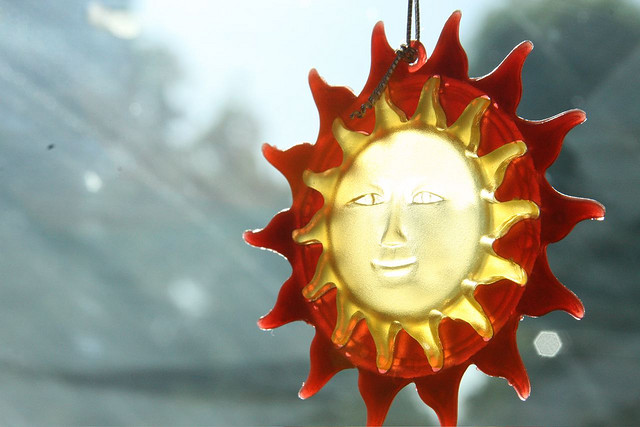
Photo © Amanda Wray, licensed Creative Commons Attribution Share-Alike.
Arizona’s incessant sun can quickly become a dangerous threat to your health. Stay in the shadows, covered from head to toe. If you’re not willing to do this, then at least wear a hat with a wide brim, use high-number sunscreen, cover your neck, and wear long sleeves. This applies not only to backcountry desert adventurers and hikers; mere sight-seers, especially children, are susceptible to sun- and heat-related health issues—more so, in fact: The less fit you are, the higher the danger. Hikers, shoppers, sightseers, golfers, and anybody else exerting themselves under high-heat conditions should watch out for dehydration.If you get a sunburn, stay out of the sun, and try to keep cool and hydrated. There are dozens of over-the-counter balms available, but simple aloe also works well. A popular home remedy is to gently dab the burned areas with vinegar. The best way to avoid sunburn is to stay out of the sun; barring that, cover up and follow common sense. Children and those with fair skin should be even more cautious.Hikers, shoppers, sightseers, golfers, and anybody else exerting themselves under high-heat conditions should watch out for dehydration. When your body becomes depleted of fluids, you’ll notice first that you are not urinating regularly and your saliva has dried up. You may become irritable and confused; your skin may turn gray and your pulse race. Children can become dehydrated quickly. The best way to avoid dehydration is to limit your exertion during the hottest part of the day and to drink a lot of water. If you feel the symptoms of dehydration coming on, get to a cool, comfortable place, take in fluids, and rest.
Hikers should take along a few packets of electrolyte powder—these can be lifesavers. If you exert yourself in the heat and sun and fail to replace the fluids flowing out, your body can become depleted of both electrolytes and fluids. Such is the path to heat exhaustion, a dangerous condition that can turn fatal if not treated. You begin to feel nauseated, dizzy, and weak, and your muscles cramp. If you experience any of these symptoms, get to a cool, comfortable place quickly and drink water and something with sodium and potassium in it.
Heat stroke, sometimes called sun stroke or heat hyperpyrexia, is a severe, dangerous health threat that is frequently fatal and changes a victim’s health significantly and irrevocably. Heat stroke occurs when the body’s temperature-regulating capacity fails; this can be caused by either relatively short exposure to extremely high heat—like, say, a short, strenuous run on a 105-degree July afternoon—or prolonged exposure to relatively high temperatures, as in a 15-mile hike in 90-degree heat. And that’s only if you’re in good shape; it would take far less to cause heat stroke in most of us. The first and most important sign of heat stroke is a lack of sweating. If you stop sweating in a situation where you should be sweating, take notice. Your heart rate will speed up noticeably, and your skin will become dry; you’ll get a headache and become confused. At its worst, heat stroke leads to unconsciousness, convulsions, and death. Once you notice you’re not sweating, you must get help immediately: Get to an emergency room as soon as possible.
In addition to heat, be aware of altitude. The mountains in Southern Arizona reach up to 10,000 feet. A few of the state’s mountain towns sit between 5,000 and 8,000 feet above sea level. Lowlanders in relatively good shape may get headaches, a little dizziness, and shortness of breath while walking around Mount Lemmon or other mountains in the region, but very few will experience serious altitude sickness—the result of not getting enough oxygen, and therefore not enough blood flow, to the brain. Take it easy in the higher elevations if you begin to feel tired and out-of-breath, dizzy, or euphoric. If you have heart or lung problems, you need to be more aware in the higher elevations; the best thing to do is to get a prescription for oxygen from your doctor and carry it with you if you plan on spending a lot of time in the mountains.
Excerpted from the Second Edition of Moon Tucson.